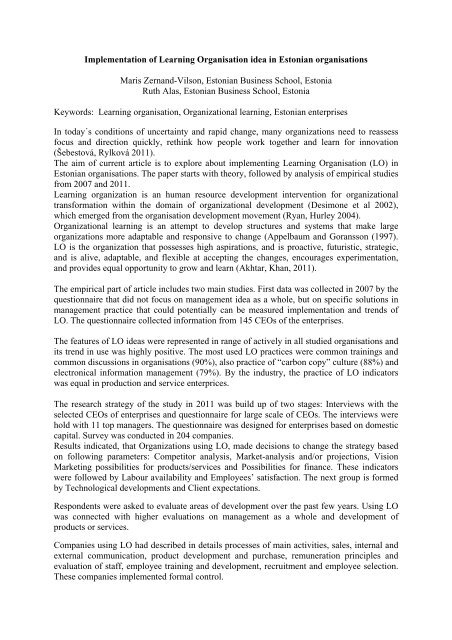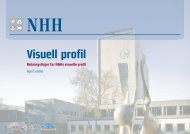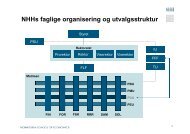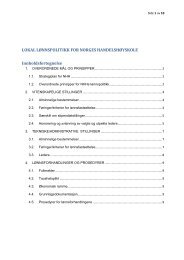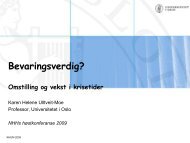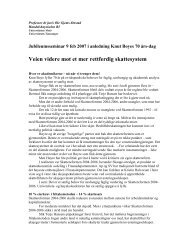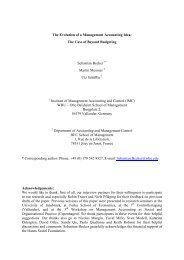Implementation of Learning Organisation idea in ... - Paraplyen
Implementation of Learning Organisation idea in ... - Paraplyen
Implementation of Learning Organisation idea in ... - Paraplyen
Create successful ePaper yourself
Turn your PDF publications into a flip-book with our unique Google optimized e-Paper software.
<strong>Implementation</strong> <strong>of</strong> <strong>Learn<strong>in</strong>g</strong> <strong>Organisation</strong> <strong>idea</strong> <strong>in</strong> Estonian organisationsMaris Zernand-Vilson, Estonian Bus<strong>in</strong>ess School, EstoniaRuth Alas, Estonian Bus<strong>in</strong>ess School, EstoniaKeywords: <strong>Learn<strong>in</strong>g</strong> organisation, Organizational learn<strong>in</strong>g, Estonian enterprisesIn today´s conditions <strong>of</strong> uncerta<strong>in</strong>ty and rapid change, many organizations need to reassessfocus and direction quickly, reth<strong>in</strong>k how people work together and learn for <strong>in</strong>novation(Šebestová, Rylková 2011).The aim <strong>of</strong> current article is to explore about implement<strong>in</strong>g <strong>Learn<strong>in</strong>g</strong> <strong>Organisation</strong> (LO) <strong>in</strong>Estonian organisations. The paper starts with theory, followed by analysis <strong>of</strong> empirical studiesfrom 2007 and 2011.<strong>Learn<strong>in</strong>g</strong> organization is an human resource development <strong>in</strong>tervention for organizationaltransformation with<strong>in</strong> the doma<strong>in</strong> <strong>of</strong> organizational development (Desimone et al 2002),which emerged from the organisation development movement (Ryan, Hurley 2004).Organizational learn<strong>in</strong>g is an attempt to develop structures and systems that make largeorganizations more adaptable and responsive to change (Appelbaum and Goransson (1997).LO is the organization that possesses high aspirations, and is proactive, futuristic, strategic,and is alive, adaptable, and flexible at accept<strong>in</strong>g the changes, encourages experimentation,and provides equal opportunity to grow and learn (Akhtar, Khan, 2011).The empirical part <strong>of</strong> article <strong>in</strong>cludes two ma<strong>in</strong> studies. First data was collected <strong>in</strong> 2007 by thequestionnaire that did not focus on management <strong>idea</strong> as a whole, but on specific solutions <strong>in</strong>management practice that could potentially can be measured implementation and trends <strong>of</strong>LO. The questionnaire collected <strong>in</strong>formation from 145 CEOs <strong>of</strong> the enterprises.The features <strong>of</strong> LO <strong>idea</strong>s were represented <strong>in</strong> range <strong>of</strong> actively <strong>in</strong> all studied organisations andits trend <strong>in</strong> use was highly positive. The most used LO practices were common tra<strong>in</strong><strong>in</strong>gs andcommon discussions <strong>in</strong> organisations (90%), also practice <strong>of</strong> “carbon copy” culture (88%) andelectronical <strong>in</strong>formation management (79%). By the <strong>in</strong>dustry, the practice <strong>of</strong> LO <strong>in</strong>dicatorswas equal <strong>in</strong> production and service enterprices.The research strategy <strong>of</strong> the study <strong>in</strong> 2011 was build up <strong>of</strong> two stages: Interviews with theselected CEOs <strong>of</strong> enterprises and questionnaire for large scale <strong>of</strong> CEOs. The <strong>in</strong>terviews werehold with 11 top managers. The questionnaire was designed for enterprises based on domesticcapital. Survey was conducted <strong>in</strong> 204 companies.Results <strong>in</strong>dicated, that Organizations us<strong>in</strong>g LO, made decisions to change the strategy basedon follow<strong>in</strong>g parameters: Competitor analysis, Market-analysis and/or projections, VisionMarket<strong>in</strong>g possibilities for products/services and Possibilities for f<strong>in</strong>ance. These <strong>in</strong>dicatorswere followed by Labour availability and Employees’ satisfaction. The next group is formedby Technological developments and Client expectations.Respondents were asked to evaluate areas <strong>of</strong> development over the past few years. Us<strong>in</strong>g LOwas connected with higher evaluations on management as a whole and development <strong>of</strong>products or services.Companies us<strong>in</strong>g LO had described <strong>in</strong> details processes <strong>of</strong> ma<strong>in</strong> activities, sales, <strong>in</strong>ternal andexternal communication, product development and purchase, remuneration pr<strong>in</strong>ciples andevaluation <strong>of</strong> staff, employee tra<strong>in</strong><strong>in</strong>g and development, recruitment and employee selection.These companies implemented formal control.
Companies us<strong>in</strong>g LO consider the follow<strong>in</strong>g factors important for employee motivation: goodcareer prospects, versatile development and tra<strong>in</strong><strong>in</strong>g opportunities, match<strong>in</strong>g company’svalues and employee’s values, attractive bonuses, social activity and charity <strong>of</strong> the companyand possibility <strong>of</strong> a career abroad.The <strong>in</strong>formation about the LO’s plans and action plans reaches the employees us<strong>in</strong>g thefollow<strong>in</strong>g channels: <strong>in</strong>-house <strong>in</strong>tranet (<strong>in</strong>ternal network), tra<strong>in</strong><strong>in</strong>g(s), non-formal communicationbetween the management and employees, division meet<strong>in</strong>gs, general meet<strong>in</strong>gs.LOs do not prefer any job/contract types: tele-work<strong>in</strong>g, contract, part-time work, outsourc<strong>in</strong>g,fixed-term work, flexi-time, job shar<strong>in</strong>g, sole proprietorship, contract<strong>in</strong>g.Processes described <strong>in</strong> details: ma<strong>in</strong> activities sales <strong>in</strong>ternal and external communication product development and purchase remuneration pr<strong>in</strong>ciples evaluation <strong>of</strong> staff employee tra<strong>in</strong><strong>in</strong>g and development recruitment and employee selection.Factors considered important foremployee motivation: good career prospects versatile development and tra<strong>in</strong><strong>in</strong>gopportunities match<strong>in</strong>g company’s values andemployee’s values attractive bonuses social activity and charity <strong>of</strong> thecompany possibility <strong>of</strong> a career abroad.<strong>Learn<strong>in</strong>g</strong> <strong>Organisation</strong>Information about organisation’splans reaches the employeesus<strong>in</strong>g: <strong>in</strong>-house <strong>in</strong>tranet (<strong>in</strong>ternal network) tra<strong>in</strong><strong>in</strong>g(s) non-formal communication betweenthe management and employees division meet<strong>in</strong>gs general meet<strong>in</strong>gs


